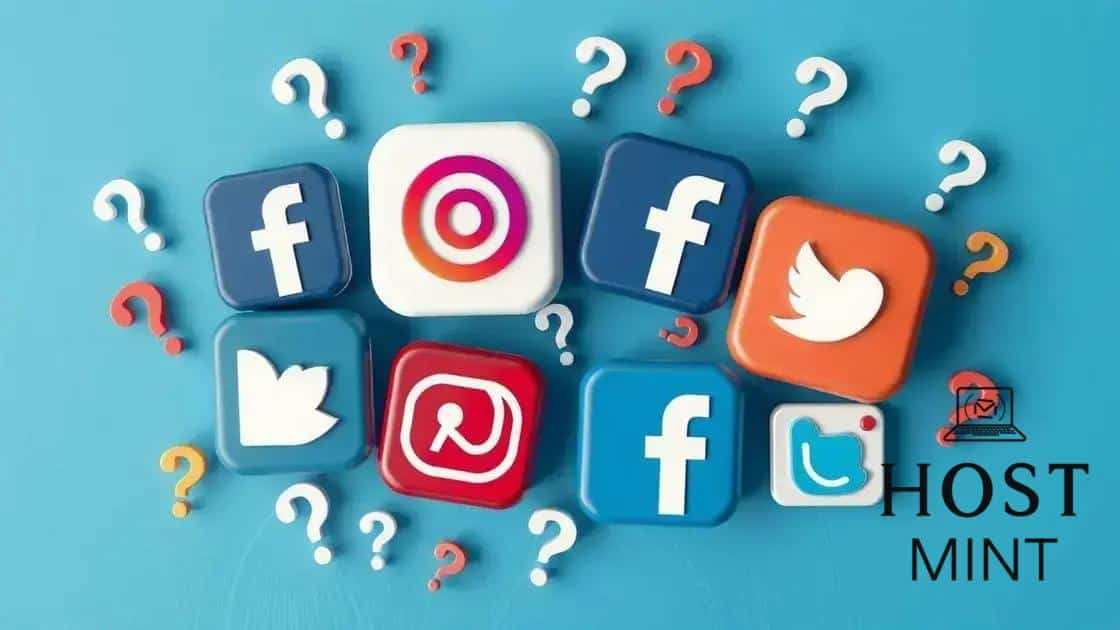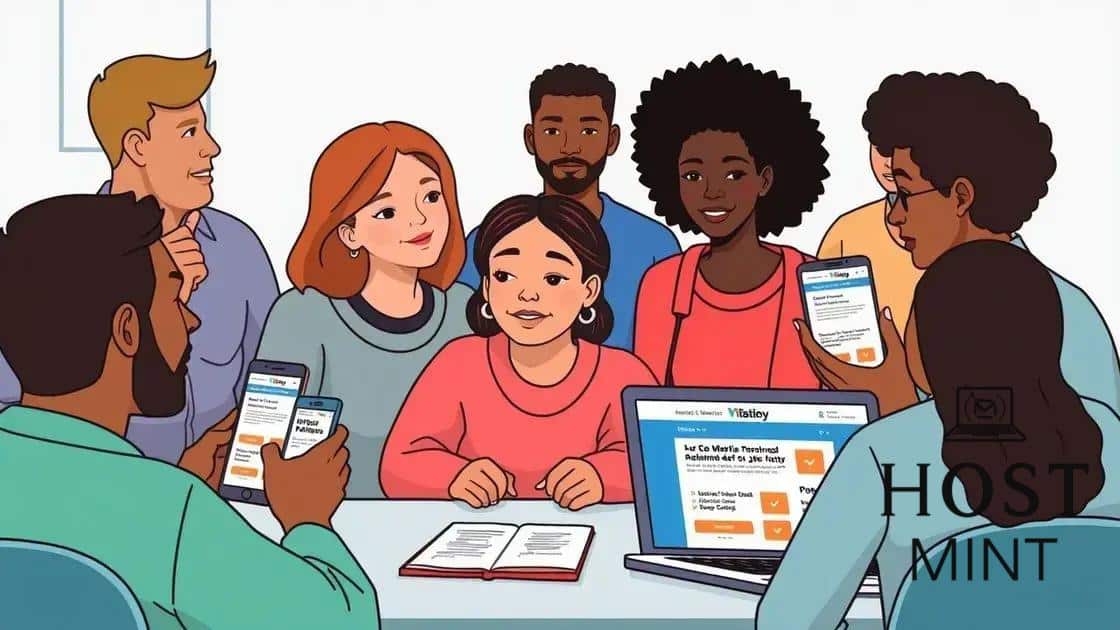Rise in misinformation campaigns on social media

The rise in misinformation campaigns on social media is fueled by algorithms prioritizing engagement and users sharing emotionally charged content, leading to significant societal impacts like public health risks and political polarization.
The rise in misinformation campaigns on social media is shaping how we perceive reality. Have you noticed how certain stories circulate and influence opinions? Let’s delve into the layers behind this phenomenon.
Understanding misinformation in the digital age
Understanding misinformation in the digital age is crucial for navigating our online world. With the rise of technology, false information spreads faster than ever, creating confusion and doubt. This section explores its nature and impact.
What is misinformation?
Misinformation refers to incorrect or misleading information shared without harmful intent. It can take many forms, including rumors and hoaxes. In today’s digital landscape, anyone can share their opinions, often blurring the line between facts and falsehoods.
Why does misinformation spread?
Several factors contribute to the rapid spread of misinformation:
- Social media platforms make sharing easy and quick.
- People tend to share information that confirms their beliefs.
- Visuals and headlines draw attention, often regardless of accuracy.
This combination creates an environment where misinformation can thrive, making it challenging to discern truth from lies.
Another key aspect is the role of emotions in sharing information. Content that provokes strong feelings, whether anger or fear, is more likely to be shared. Thus, misinformation often capitalizes on emotional triggers to spread swiftly.
Additionally, algorithms on social media platforms often prioritize engagement over accuracy. This means that sensational or misleading posts can gain more visibility than factual ones, leading to widespread misinformation.
The implications of misinformation
The implications of misinformation are significant. It can alter public opinions, influence elections, and even endanger lives. For instance, false health information can lead to poor choices, affecting personal and public health.
In conclusion, understanding the dynamics of misinformation in our digital age is essential. As consumers of information, we must learn to identify and question sources, ensuring we make informed decisions.
Factors contributing to misinformation spread

Many factors contribute to the spread of misinformation in today’s digital landscape. These elements create a perfect storm where false information flourishes, making it more critical than ever to understand how it happens.
Social media algorithms
The algorithms used by social media platforms play a significant role in amplifying misinformation. They prioritize content that generates high engagement, often leading to sensational news rising to the top of feeds. This means that the more shocking or outrageous a post is, the more likely it will be shared.
Emotional engagement
Content that triggers strong emotions tends to spread more quickly. People are more inclined to share posts that make them feel happy, angry, or scared. This emotional response can cloud judgment and lead to the sharing of unverified claims.
- Anger and fear drive shares more than factual information.
- Positive stories can also mislead if exaggerated or unverified.
- Emotions significantly impact decision-making processes.
As individuals, we often prefer sharing content that resonates on a personal level, whether through humor or relatable experiences. This can create an echo chamber, where misinformation is reinforced within groups with similar beliefs.
The role of influencers and celebrities
Influencers and celebrities have substantial power over their followers. When they share information, whether intentionally or unintentionally misleading, it can quickly reach millions. Their authority often leads people to take their words at face value, giving misinformation a platform.
This phenomenon highlights the need for critical thinking when consuming information online. Understanding who shares what and the context behind it is vital for separating fact from fiction.
In addition, the sheer volume of information available today makes it challenging to fact-check everything we see. With so many sources competing for attention, individuals must be discerning in how they evaluate the reliability of the content they encounter.
Consequences of misinformation on society
The consequences of misinformation on society are profound and far-reaching. As false information spreads, it can significantly impact public opinion, decision-making, and even social cohesion.
Impact on public health
One of the most concerning consequences of misinformation is its effect on public health. During health crises, such as the COVID-19 pandemic, false information about vaccines and treatments led to vaccine hesitancy. This has resulted in lower vaccination rates and prolonged public health risks.
Political polarization
Misinformation can also deepen political divides. When people receive misleading information that aligns with their beliefs, it reinforces their views and creates an us-versus-them mentality. This polarization can lead to conflict, making it difficult for society to come together on important issues.
- Society may become more divided over issues like climate change.
- Trust in institutions can erode due to misinformation campaigns.
- Political discourse may shift from constructive debate to hostility.
This polarization results in a lack of productive dialogue, hindering democracy and social progress.
Effects on community trust
Misinformation also damages community trust. When individuals encounter false information, they may begin to doubt reputable sources of information. This skepticism can discourage people from seeking accurate information, leading to an uninformed public.
As trust diminishes, individuals may rely more on echo chambers, where they only hear views that reinforce their biases. This creates a cycle of misinformation, where false beliefs perpetuate further falsehoods.
Ultimately, the societal consequences of misinformation highlight the need for improved media literacy. People must learn to critically evaluate the information they consume and understand the importance of verifying sources before sharing.
Strategies to combat misinformation online

Combating misinformation online requires a multifaceted approach. Each strategy plays a critical role in helping individuals and communities assess the reliability of information they encounter.
Promoting media literacy
One effective way to combat misinformation is to enhance media literacy. Teaching people how to critically evaluate sources and recognize credible information is essential. Workshops and online resources can help individuals understand:
- How to spot unreliable sources.
- The importance of fact-checking.
- The role of bias in media reporting.
By fostering these skills, people become more discerning consumers of information, which can reduce the spread of falsehoods.
Encouraging fact-checking
Fact-checking is another valuable strategy in the fight against misinformation. Reliable fact-checking websites can provide quick verification of information. Encouraging individuals to check claims before sharing them online can significantly decrease the spread of false information.
Some tips for effective fact-checking include:
- Searching for multiple sources on the same topic.
- Looking for articles from reputable news organizations.
- Using established fact-checking websites like Snopes or FactCheck.org.
This proactive approach allows people to verify the accuracy of claims, helping to maintain informed discussions.
Strengthening community guidelines
Another important avenue is strengthening community guidelines on social media platforms. Many platforms are now implementing stricter rules against the spread of misinformation. This includes labeling false content or removing it entirely. Engaging users to report misleading posts also fosters a community effort against misinformation.
It’s essential for platforms to clearly communicate what constitutes misinformation and ensure users understand the implications of spreading false information.
Ultimately, combating misinformation online is a collective effort. By promoting education, fact-checking, and community engagement, we can create a more informed society that values accurate information.
The role of social media platforms in misinformation
Social media platforms play a pivotal role in the spread of misinformation. These platforms connect billions of users, providing a space for information exchange. However, their influence can lead to both positive and negative outcomes regarding the accuracy of shared content.
Algorithms and content visibility
The algorithms used by social media platforms are designed to enhance user engagement. This means that content which generates strong reactions tends to be prioritized. Unfortunately, misinformation often fits this mold. Outrageous or sensational claims can attract more likes, shares, and comments, thus receiving increased visibility.
The challenge of regulation
Another challenge is the regulation of content on these platforms. Social media companies are tasked with managing the vast amount of information shared daily. This includes distinguishing between fact and fiction, something that is not always straightforward. They employ various methods such as:
- Automated fact-checking tools.
- User reporting systems.
- Collaboration with external fact-checking organizations.
While these methods can help, they are not foolproof. As misinformation evolves, so must the strategies to combat it.
User responsibility
Users also play a significant role in the information ecosystem. Many individuals share posts without verifying their accuracy, contributing to the problem. By encouraging critical thinking and skepticism towards unverified claims, users can help limit the spread of misinformation. It is crucial for users to:
- Verify information before sharing it.
- Seek credible sources for news and updates.
- Engage in discussions that promote fact-based information.
Ultimately, the role of social media platforms in the realm of misinformation is complex. While they serve as valuable tools for communication, they also have the potential to perpetuate falsehoods. Understanding this dynamic allows for better engagement and more informed discussions online.
FAQ – Frequently Asked Questions about Misinformation on Social Media
What is misinformation?
Misinformation refers to false or misleading information shared without harmful intent, often spread through social media.
How does social media contribute to misinformation?
Social media platforms amplify misinformation by prioritizing content that generates high engagement, often regardless of its accuracy.
What can I do to combat misinformation?
You can combat misinformation by promoting media literacy, verifying information before sharing, and being an active and informed participant in online discussions.
Why is media literacy important?
Media literacy is crucial because it helps individuals discern credible sources from unreliable ones, reducing the spread of misinformation and promoting informed decision-making.






